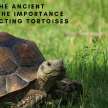Saving the Ancient Giants: The Importance of Protecting Tortoises
Exploring the threats facing tortoises and the actions we can take to save these ancient animals

Tortoises are fascinating creatures that have been around for millions of years, and yet, despite their ancient history, they are now facing a number of threats that are putting their survival at risk. In this blog post, we will explore the reasons why tortoises need to be saved, and what we can do to help protect these amazing animals.
First, it's important to understand a little bit about the biology of tortoises. They are reptiles, and belong to the family Testudinidae. This family includes both land-dwelling and freshwater species, but most tortoises are terrestrial and live on land. They have a hard, protective shell that covers their body, and their legs are short and sturdy, with thick, clawed toes that help them to move around on rough terrain.
Tortoises are also incredibly long-lived creatures. Some species can live for over 100 years, making them one of the longest-lived animals on the planet. This is one of the reasons why they are so important to conserve - they play a crucial role in maintaining the balance of ecosystems and have a unique place in the natural world.
Unfortunately, despite their ancient history and important role in the environment, tortoises are now facing a number of threats. The biggest threat to their survival is habitat destruction. As human populations continue to grow and expand, more and more land is being cleared for agriculture, housing, and other human uses. This means that tortoises are losing the habitats they need to survive.
In addition to habitat destruction, tortoises are also threatened by hunting and poaching. Some people hunt tortoises for their meat, while others collect them as pets. This has led to a decline in tortoise populations in many areas.
Climate change is also a major threat to tortoises. As temperatures rise and weather patterns change, tortoises are finding it harder to survive. In some areas, they are experiencing extreme heat and drought, which makes it difficult for them to find food and water. In other areas, they are experiencing floods and storms, which can wash away their habitats and make it difficult for them to move around.
So what can be done to save these ancient creatures? The first step is to protect and restore their habitats. This means creating protected areas where tortoises can live and breed safely, and working to restore habitats that have been destroyed. It also means managing land use in a way that is sustainable and allows for the survival of tortoises and other wildlife.
Another important step is to enforce laws that protect tortoises from hunting and poaching. This means working with local communities to educate them about the importance of tortoises and the dangers of hunting and collecting them, and enforcing laws that prohibit hunting and poaching.
We can also work to mitigate the effects of climate change on tortoises by reducing our carbon emissions and taking other actions to slow the warming of the planet. This can help to protect tortoises and other wildlife from the worst effects of climate change.
Finally, we can support conservation efforts that are working to save tortoises. This includes supporting organizations that are working to protect and restore tortoise habitats, and funding research that is helping to better understand these amazing animals and how to protect them.
Tortoises are ancient creatures that have been around for millions of years, but despite their long history, they are now facing a number of threats that are putting their survival at risk. But with our help, we can work to protect these amazing animals and ensure that they continue to thrive for many years to come.
- According to the International Union for Conservation of Nature (IUCN), more than 50% of tortoise and turtle species are threatened with extinction. This puts them at a higher risk of extinction than mammals, birds, and amphibians.
- The Galapagos tortoise is one of the most critically endangered species of tortoise, with only around 20,000 individuals remaining in the wild. The main threat to their survival is habitat destruction caused by human activities such as agriculture and urbanization.
- The African spurred tortoise (also known as the sulcata tortoise) is another species that is facing a high risk of extinction. They are native to the Sahel region of Africa, but their population has declined by more than 90% in the last century. This is mainly due to hunting and habitat destruction caused by human activities such as agriculture and urbanization.
- The Radiated tortoise, native to Madagascar, is listed as critically endangered by the IUCN. The main threat to the survival of this species is habitat loss and fragmentation due to human activities such as agriculture and urbanization.
- The Gopher tortoise, native to the southeastern United States, is listed as a threatened species under the Endangered Species Act. The main threat to the survival of this species is habitat loss and fragmentation due to human activities such as agriculture and urbanization.
- Conservation efforts have been successful in some cases, such as the Aldabra giant tortoise in the Seychelles, which was brought back from the brink of extinction through a successful breeding program.
Another way to save tortoises is through education and awareness raising. By educating local communities and raising awareness about the importance of tortoises, we can help to reduce hunting and poaching. Additionally, educating people on how to coexist with tortoises can help to minimize human-tortoise conflicts. This can be done through educational programs in schools, workshops for farmers, and community outreach campaigns.
Research is also crucial for understanding the threats facing tortoises and developing effective conservation strategies. This includes studying the ecology and behavior of tortoises, as well as monitoring their population trends. By funding research, we can gain a better understanding of how to protect and conserve tortoises in the wild.
As individuals, we can also take action to help save tortoises. For example, we can reduce our carbon footprint, support conservation organizations, and make sustainable consumer choices. By choosing products that are not made from tortoise shells, we can help to reduce the demand for products that contribute to the illegal trade in tortoise products.
In summary, tortoises are ancient creatures that have an important place in the natural world. However, they are facing a number of threats to their survival, including habitat destruction, hunting, and the effects of climate change. To save these ancient animals, we must take action to protect and restore their habitats, enforce laws that prohibit hunting and poaching, and work to mitigate the effects of climate change. Additionally, by educating local communities, funding research, and taking individual actions, we can help to ensure that tortoises continue to thrive for many years to come.
In conclusion, tortoises are ancient and fascinating creatures that have an important place in the natural world. However, they are currently facing a number of threats to their survival, including habitat destruction, hunting, and the effects of climate change. To save these ancient animals, it is crucial that we take action to protect and restore their habitats, enforce laws that prohibit hunting and poaching, and work to mitigate the effects of climate change. By supporting conservation efforts, educating local communities, and funding research, we can help to ensure that tortoises continue to thrive for many years to come. We all have a role to play in protecting these amazing animals and preserving their place in the natural world for future generations to enjoy.
About the Creator
Ramalingam
I'm interested in social, sports, tech, & food. I enjoy sharing my insights on latest trends & happenings. My blog features a mix of informative articles & personal musings. Thanks for reading!






Comments
There are no comments for this story
Be the first to respond and start the conversation.